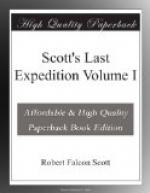The sun has been obstinate all day, peeping out occasionally and then shyly retiring; it makes a great difference to comfort.
Programme
Bruce continually checking speed with hand log.
Bowers taking altitudes of
objects as they come abeam.
Nelson noting results.
Pennell taking verge plate
bearings on bow and quarter.
Cherry-Garrard noting results.
Evans taking verge plate bearings
abeam.
Atkinson noting results.
Campbell taking distances
abeam with range finder.
Wright noting results.
Rennick sounding with Thomson
machine.
Drake noting results.
Beaufort Island looks very black from the south.
10.30.—We find pack off Cape Bird; we have passed through some streams and there is some open water ahead, but I’m afraid we may find the ice pretty thick in the Strait at this date.
Wednesday, January 4, 1 A.M.—We are around Cape Bird and in sight of our destination, but it is doubtful if the open water extends so far.
We have advanced by following an open water lead close along the land. Cape Bird is a very rounded promontory with many headlands; it is not easy to say which of these is the Cape.
The same grim unattainable ice-clad coast line extends continuously from the Cape Crozier Rookery to Cape Bird. West of C. Bird there is a very extensive expanse of land, and on it one larger and several small penguin rookeries.
On the uniform dark reddish brown of the land can be seen numerous grey spots; these are erratic boulders of granite. Through glasses one could be seen perched on a peak at least 1300 feet above the sea.
Another group of killer whales were idly diving off the penguin rookery; an old one with a very high straight dorsal fin and several youngsters. We watched a small party of penguins leaping through the water towards their enemies. It seemed impossible that they should have failed to see the sinister fins during their frequent jumps into the air, yet they seemed to take no notice whatever—stranger still, the penguins must have actually crossed the whales, yet there was no commotion whatever, and presently the small birds could be seen leaping away on the other side. One can only suppose the whales are satiated.
As we rounded Cape Bird we came in sight of the old well-remembered land marks—Mount Discovery and the Western Mountains—seen dimly through a hazy atmosphere. It was good to see them again, and perhaps after all we are better this side of the Island. It gives one a homely feeling to see such a familiar scene.
4 A.M.—The steep exposed hill sides on the west side of Cape Bird look like high cliffs as one gets south of them and form a most conspicuous land mark. We pushed past these cliffs into streams of heavy bay ice, making fair progress; as we proceeded the lanes became scarcer, the floes heavier, but the latter remain loose. ’Many of us spent the night on deck as we pushed through the pack.’ We have passed some very large floes evidently frozen in the strait. This is curious, as all previous evidence has pointed to the clearance of ice sheets north of Cape Royds early in the spring.




